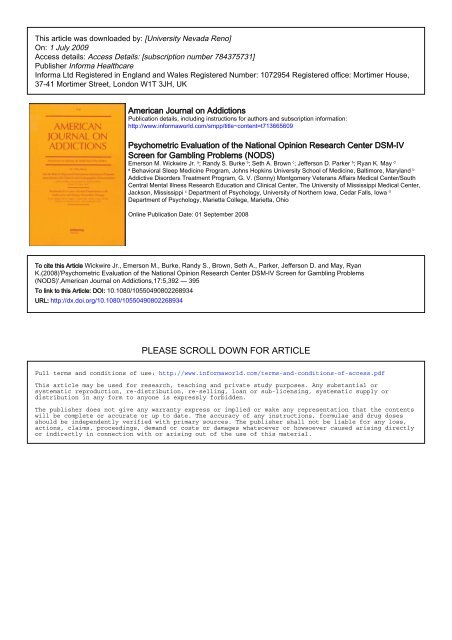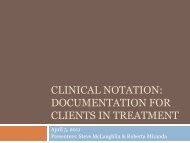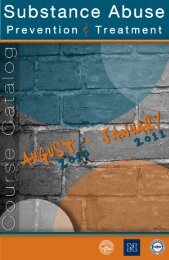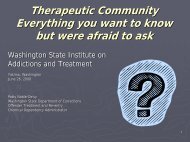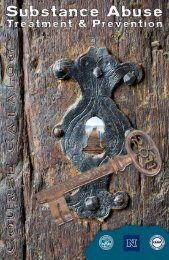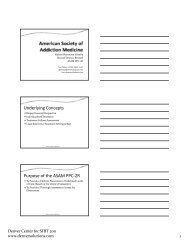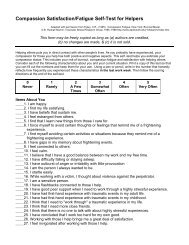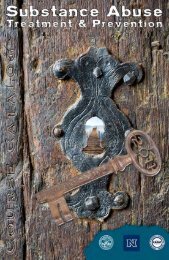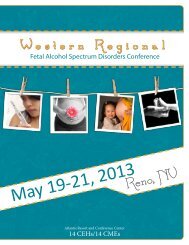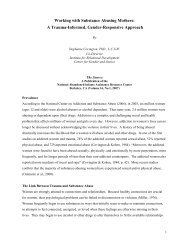Wickwire, E. M., Jr., Burke, R. S., Brown, S. A., Parker, J. D. ... - CASAT
Wickwire, E. M., Jr., Burke, R. S., Brown, S. A., Parker, J. D. ... - CASAT
Wickwire, E. M., Jr., Burke, R. S., Brown, S. A., Parker, J. D. ... - CASAT
You also want an ePaper? Increase the reach of your titles
YUMPU automatically turns print PDFs into web optimized ePapers that Google loves.
This article was downloaded by: [University Nevada Reno]On: 1 July 2009Access details: Access Details: [subscription number 784375731]Publisher Informa HealthcareInforma Ltd Registered in England and Wales Registered Number: 1072954 Registered office: Mortimer House,37-41 Mortimer Street, London W1T 3JH, UKAmerican Journal on AddictionsPublication details, including instructions for authors and subscription information:http://www.informaworld.com/smpp/title~content=t713665609Psychometric Evaluation of the National Opinion Research Center DSM-IVScreen for Gambling Problems (NODS)Emerson M. <strong>Wickwire</strong> <strong>Jr</strong>. a ; Randy S. <strong>Burke</strong> b ; Seth A. <strong>Brown</strong> c ; Jefferson D. <strong>Parker</strong> b ; Ryan K. May daBehavioral Sleep Medicine Program, Johns Hopkins University School of Medicine, Baltimore, Maryland bAddictive Disorders Treatment Program, G. V. (Sonny) Montgomery Veterans Affairs Medical Center/SouthCentral Mental Illness Research Education and Clinical Center, The University of Mississippi Medical Center,Jackson, Mississippi c Department of Psychology, University of Northern Iowa, Cedar Falls, Iowa dDepartment of Psychology, Marietta College, Marietta, OhioOnline Publication Date: 01 September 2008To cite this Article <strong>Wickwire</strong> <strong>Jr</strong>., Emerson M., <strong>Burke</strong>, Randy S., <strong>Brown</strong>, Seth A., <strong>Parker</strong>, Jefferson D. and May, RyanK.(2008)'Psychometric Evaluation of the National Opinion Research Center DSM-IV Screen for Gambling Problems(NODS)',American Journal on Addictions,17:5,392 — 395To link to this Article: DOI: 10.1080/10550490802268934URL: http://dx.doi.org/10.1080/10550490802268934PLEASE SCROLL DOWN FOR ARTICLEFull terms and conditions of use: http://www.informaworld.com/terms-and-conditions-of-access.pdfThis article may be used for research, teaching and private study purposes. Any substantial orsystematic reproduction, re-distribution, re-selling, loan or sub-licensing, systematic supply ordistribution in any form to anyone is expressly forbidden.The publisher does not give any warranty express or implied or make any representation that the contentswill be complete or accurate or up to date. The accuracy of any instructions, formulae and drug dosesshould be independently verified with primary sources. The publisher shall not be liable for any loss,actions, claims, proceedings, demand or costs or damages whatsoever or howsoever caused arising directlyor indirectly in connection with or arising out of the use of this material.
The American Journal on Addictions, 17: 392–395, 2008Copyright C○ American Academy of Addiction PsychiatryISSN: 1055-0496 print / 1521-0391 onlineDOI: 10.1080/10550490802268934Psychometric Evaluation of the National Opinion ResearchCenter DSM-IV Screen for Gambling Problems (NODS)Emerson M. <strong>Wickwire</strong>, <strong>Jr</strong>., PhD, 1 Randy S. <strong>Burke</strong>, PhD, 2 Seth A. <strong>Brown</strong>, PhD, 3Jefferson D. <strong>Parker</strong>, PhD, 2 Ryan K. May, PhD 41 Behavioral Sleep Medicine Program, Johns Hopkins University School of Medicine, Baltimore, Maryland2 Addictive Disorders Treatment Program, G. V. (Sonny) Montgomery Veterans Affairs Medical Center/South Central MentalIllness Research Education and Clinical Center/The University of Mississippi Medical Center, Jackson, Mississippi3 Department of Psychology, University of Northern Iowa, Cedar Falls, Iowa4 Department of Psychology, Marietta College, Marietta, OhioDownloaded By: [University Nevada Reno] At: 18:59 1 July 2009The present study examined the reliability, validity, andclinical utility of a brief self-report measure of gamblingbehavior, the National Opinion Research Center DSM-IVScreen for Gambling Problems (NODS). Participants were 157consecutively enrolled male military veterans taking part insubstance use disorder treatment. The NODS displayed goodinternal consistency. Concurrent and discriminant validitywere demonstrated by comparing scores on the NODS toscores on the South Oaks Gambling Screen and to a measure ofmedical problems, respectively. Overall, the NODS appears tobe a reliable, valid, and clinically useful measure of gamblingproblems among patients in substance use disorder treatmentprograms. (Am J Addict 2008;17:392–395)Since its inclusion in the third edition of the Diagnosticand Statistical Manual of Mental Disorders as a psychiatricdisorder, 1 pathological gambling has been increasingly recognizedas a condition with significant individual, familial,and societal costs. 2 It is estimated that between 1–2% ofthe United States adult population meets diagnostic criteriafor pathological gambling, with an additional 3% at riskfor the development of gambling problems. 3–5 In the UnitedStates, the direct and indirect costs of pathological gamblinghave been estimated at $32.4 to $53.8 billion for the year2003. 6Although pathological gambling is currently classified as animpulse control disorder, the DSM-IV 7 diagnostic criteria forpathological gambling include tolerance, preoccupation, andwithdrawal, and resemble those for substance use disorders. 8,9Received September 13, 2007; revised October 31, 2007; acceptedJanuary 29, 2008.Address correspondence to Dr. <strong>Burke</strong>, Addictive DisordersTreatment Program (116A4), G. V. (Sonny) Montgomery, VeteransAffairs Medical Center, 1500 East Woodrow Wilson Drive, JacksonMS 39216. E-mail: randy.burke@va.gov.Further, it is well documented that pathological gamblingis likely to co-occur in individuals with substance abusedisorders. 4,10,11 Not only are individuals with gamblingproblems at increased risk for substance abuse disorders, 12 butrates of pathological gambling are higher among individualsseeking treatment for substance abuse than in the generalpopulation. 12–15 For these reasons, the assessment of gamblingbehavior should be an important aspect of substance abusetreatment. 15 However, available screening measures needfurther empirical validation to support their use in clinicalsamples. 16In a national gambling study commissioned by the UnitedStates Congress, Gerstein et al. 4 developed a DSM-IVbased screening tool, the National Opinion Research CenterDiagnostic Screen for Gambling Problems, or NODS. Incommunity and clinical samples, the NODS has been foundto be highly correlated with the South Oaks GamblingScreen (SOGS), 17 a commonly used DSM-III based screenfor gambling problems, 18,19 although the NODS has consistentlyproduced lower estimates of pathological gambling. 20Among individuals in treatment for gambling problems,the NODS has been utilized as a measure of treatmentoutcome. 21 Yet psychometric evaluation of the NODS remainssparse, and there has been a call for increased psychometricevaluation to correspond with the increased use of theinstrument. 18To our knowledge, no study has evaluated the performanceof the NODS in a sample of individuals undergoing treatmentfor substance abuse. Therefore, the purpose of the presentstudy was to examine the reliability, validity, and clinicalutility of the NODS for assessing gambling problems amongparticipants in a substance use disorder treatment program. Wehypothesized that the NODS would display good psychometricproperties and be positively correlated with a standardizedand well-validated measure of gambling problems (i.e.,the SOGS).392
Downloaded By: [University Nevada Reno] At: 18:59 1 July 2009METHODSParticipantsParticipants were 157 male African-American (62.2%) andCaucasian (37.8%) military veterans (mean age = 46.5 years,SD= 8.21) consecutively enrolled in primary residential orday treatment for substance use disorders. Twenty-four percentof the sample reported being single, 14% were married, and57.3% were divorced or separated. Participants reported amean of 12.9 years (SD = 2.0) of education. Based on aclinical interview, all participants met criteria for substancedependence, with alcohol, cocaine, and marijuana dependencebeing major problems within this sample. Thirty-six percent ofparticipants were also diagnosed with a co-occurring psychiatriccondition, including psychotic disorders (14.8%), mooddisorders (12.1%), post-traumatic stress disorder (6.0%),cognitive disorders (1.1%), personality disorder (0.7%), ormultiple psychiatric diagnoses (2.7%).MeasuresAddiction Severity Index (ASI)The ASI 22 is a semi-structured interview that assessesdemographics as well as recent (ie, 30-day) difficulties withsubstance abuse and five related domains likely to be impactedby substance abuse (i.e., medical, employment/economic,legal, family/social, and psychiatric). For each of the sevendomains, the ASI yields non-standardized composite scoresranging from .00 to 1.00 with higher scores indicting greaterproblem severity. In the current study, we utilized the medicalcomposite subscale score of the ASI.National Opinion Research Center DSM-IV Screen forGambling Problems (NODS)The NODS 4 is a 21-item measure designed to assessproblematic gambling behaviors. In the present study, thelifetime version of the NODS was used. The first four questionsaddress gambling history and serve as screening items. Inthe original NODS report, 4 individuals who reported everhaving lost $100 or more in a day were administered theremainder of the questionnaire. These 17 items address the10 DSM-IV diagnostic criteria for pathological gambling andare scored using a yes–no format. 7 Total scores can rangefrom 0 to 10, with higher scores indicating more gamblingproblems. A score of 1 or 2 indicates at-risk gambling, anda score of 3 or 4 suggests problem gambling. Individualswho score 5 or more are labeled pathological gamblers. Toaccommodate the range of socioeconomic statuses of patientsin our treatment program, in the current study, individualswho reported ever having gambled were administered the fullquestionnaire. Gerstein et al. 4 reported excellent test-retestreliability for the lifetime NODS (r=.99, p= .01). Amongindividuals seeking treatment for pathological gambling, theNODS has demonstrated fair to good internal consistency. 18,23Convergent validity has been displayed by correlating scoreson the NODS with scores on the SOGS, with correlationsranging from r= .71 (p< .01) 23 to r= .86 (p< .001). 18South Oaks Gambling Screen (SOGS)The SOGS 17 assesses negative feelings and behaviorsassociated with gambling involvement. Twenty items are eitheranswered affirmatively or negatively and yield a score of1 or 0, respectively. Scores of 5 or more suggest probablepathological gambling. The SOGS has demonstrated adequatereliability and validity, including an excellent Cronbach’salpha (α= 0.97) and adequate test-retest correlation (r=0.71, p< .01). 17 Convergent validity was demonstrated bycomparing the SOGS scores with counselors’ assessmentof pathological gambling for an inpatient sample (r= 0.86,p< .01). 17ProcedureThis study was approved by the Veterans Affairs MedicalCenter Research and Development Committee. As part of aroutine intake assessment, all participants were administeredthe ASI, NODS, and SOGS within the first few days followingtheir admission to the treatment program.RESULTSGambling BehaviorLifetime gambling was assessed using the NODS, and88% (n= 138) of the sample reported having gambled atleast once in their lives. Involvement in specific gamblingactivities was assessed using the SOGS, and 52.8% of thesample (n = 83) reported regular gambling (weekly or dailyparticipation in at least one gambling activity). Using a 0–1coding system for no involvement versus any involvement,respectively, the most common forms of gambling wereplaying games of skill (eg, “bowling, shooting pool, playinggolf, or playing some other game of skill for money”; 22.3%,n = 35), bingo (21.0%, n= 33), betting on state lotteries(20.4%, n = 32), and playing cards for money (20.4%, n=32).The mean SOGS score was 2.19 (SD = 3.94). Based onSOGS scores, participants were divided into two problemgambling categories: no problem (86.6%) and probablepathological (13.5%). The mean NODS score was 1.50 (SD =2.67). Based on NODS scores, participants were divided intofour problem gambling categories: no problem (58%), at-risk(17.4%), problem (8.7%), and pathological (15.9%). Table 1presents rates of problem gambling for the SOGS and NODS.Internal Consistency of the SOGS and NODSThe SOGS and NODS both demonstrated good internalconsistency (α= .93 and α= .88, respectively).Concurrent ValidityIn order to evaluate the concurrent validity of the NODS,we correlated raw scores on the NODS with raw scores on theSOGS. A strong positive correlation (r = .85, p
Downloaded By: [University Nevada Reno] At: 18:59 1 July 2009TABLE 1. Cross-Tabulation of No Problem, At-Risk, Problem, andPathological Gamblers Based on Scores on the National OpinionResearch Center DSM-IV Screen for Gambling Problems (NODS) andthe South Oaks Gambling Screen (SOGS; N = 157)NODS classificationNo Atproblemrisk Problem PathologicalSOGS classificationNo problem 96 16 2 4Probable pathological 3 8 10 18concordance between the instruments. As presented in Table1, 39 individuals scored in the “probable pathological” rangeon the SOGS. Based on participants NODS scores, six wereidentified as “problem” or “pathological” gamblers with scoresof 2–3 or greater than 4, respectively, and an additional 16 wereidentified as “at-risk” gamblers.Discriminant ValidityTo evaluate the discriminant validity of the NODS, wecomputed the zero-order correlations between the participants’NODS scores and medical composite subscale scores fromthe ASI (M = .46, SD = .34). No significant correlationwas detected (r = .06, p = .49). Following the procedureof Hodgins 21 and Wulfert, 24 we also correlated NODS scoreswith participants’ ages. No significant correlation was detected(r =−.02, p = .82).DISCUSSIONIt is well documented that individuals with substanceuse disorders are at increased risk for gambling problems,relative to the general population. Therefore, the assessmentof gambling problems should be an important part of substanceabuse treatment. 15 In the present study, we evaluated theperformance of a brief, DSM-IV-based screening measure,the NODS, for measuring gambling behavior and problemsamong individuals entering day or residential substance abusetreatment.Our results are consistent with previous literature, 4,10–15demonstrating that gambling is a common activity amongpatients with substance abuse disorders. Nearly nine out often participants reported lifetime gambling, and over half ofour sample reported regular gambling (i.e., at least weeklyparticipation in at least one gambling activity.) This level ofregular gambling is notably high. Interestingly, a considerablenumber of male military veterans in the current sample reportedparticipating in bingo, a form of gambling not typicallyassociated with this population. One possible explanation forthis high rate of endorsement is that bingo is offered as arecreational opportunity at the VA where participants receivedtreatment. Unlike traditional bingo parlors, however, there isno cost associated with playing. Specifically, veterans receiveseveral bingo cards and winners receive canteen coupons ortokens that they can redeem in the hospital store.Finally, the possibility that a large number of participantswould also experience harm from their gambling was alsosupported. Approximately one out of four participants scoredin the “probable pathological” range on the SOGS. Althoughthe NODS was less sensitive in detecting gambling problems,our results support the notion that the assessment of gamblingproblems should be an important consideration for providersof substance abuse treatment. 15The primary hypotheses of the study—namely, that theNODS would perform well psychometrically and demonstrategood clinical utility—were supported. The NODSdemonstrated a high level of internal consistency reliability,as well as adequate levels of concurrent and discriminantvalidity relative to standardized and well-validated measuresof problem gambling and medical problems, respectively.Although there are no pre-determined criteria for establishingconvergent validity, the magnitude of correlation (r= .85)between the NODS and SOGS exceeded what could beconsidered a conservative threshold of r= .8 and also wasconsistent with previous research. 18,23 At the same time andconsistent with previous research, 20 the NODS was notablymore conservative than the SOGS in identifying problem orpathological gamblers. This may be an important benefit, giventhat the SOGS has been criticized for a high false positive ratein the general population. 25A growing body of evidence supports the accuracy of theDSM-IV criteria for identifying pathological gambling. 16,26,27In this light, a major advantage of the NODS is that itwas developed specifically to assess the DSM-IV criteria forpathological gambling. Given the importance of utilizing upto-datediagnostic criteria, its use will continue to increase. Asa helpful reviewer pointed out, the NODS is now mandatoryfor all patients entering substance abuse treatment in the stateof Michigan. Of course, the NODS is not without criticism.Stinchfield, Govini, and Frisch 28 note that the at-risk and problemcategories of the NODS are not supported by empiricalevidence. In light of a growing body of research supportinga continuum of problem gambling, 18 future research shouldinvestigate more fully the meaning of the subclinical diagnosticcategories. 29The present study has several strengths. First, there hasbeen a consistent call for increased evaluation of gamblingamong members of ethnic minorities, and our ethnicallydiverse sample included both African American and Caucasianparticipants. Second, our sample consisted of patients withnumerous psychiatric comorbidities who were undergoingday or residential treatment for substance abuse. Our resultsare consistent with previous literature that has reportedhigh rates of pathological gambling among individuals withpsychiatric comorbidities, and substance use disorders inparticular. 13,14 There is a paucity of psychometric analysisof the NODS in the literature, 18 and we performedsound statistical analyses to evaluate relations betweenvariables.394 Psychometric Evaluation of the NODS September–October 2008
Downloaded By: [University Nevada Reno] At: 18:59 1 July 2009Several limitations to the current study must also be noted.First, our sample consisted of only male military veterans, andthe generalizability of the current results is unknown. Second,each instrument was administered once only, so we wereunable to evaluate the temporal stability of the measures. Third,this study considered only the relation between the NODS andthe SOGS and did not include a “gold standard” structuredinterview to diagnose problem gambling status. As a result, itis impossible to determine the classification accuracy of theNODS, or to compare the accuracies of the NODS and SOGS.Despite these limitations, however, the NODS appears to bea reliable, valid, and clinically useful means for identifyingindividuals who might be experiencing difficulties related totheir gambling behavior. Future research should continue toevaluate the performance of this DSM-IV based measure.This work was supported in part by the South Central MentalHealth Research, Education Clinical Center (MIRECC).The authors would like to express a special thanks to MartyHenshaw and Peter Haik for their assistance with this project.REFERENCES1. American Psychiatric Association. Diagnostic and Statistical Manualof Mental Disorders. 3rd ed. Washington, DC: American PsychiatricAssociation; 1980.2. National Research Council. Pathological Gambling: A Critical Review.Washington, DC: National Academy Press; 1999.3. Cunningham-Williams RM, Grucza RA, Cottler LB, et al. Prevalence andpredictors of pathological gambling: results from the St. Louis personality,health and lifestyle (SLPHL) study. J Psychiatr Res. 2005;39:377–390.4. Gerstein D, Hoffman J, Larison C, et al. Gambling Impact and BehaviorStudy: Report to the National Gambling Impact Study Commission.Chicago, Ill.: National Opinion Research Center at the University ofChicago; 1999.5. Shaffer HJ, Hall MN, Vander Bilt J. Estimating the prevalence ofdisordered gambling behavior in the United States: A research synthesis.Am J Public Health. 1999;89:1369–1376.6. Grinols E. Gambling in America: Costs and Benefits. Cambridge, UK:Cambridge University Press; 2004.7. American Psychiatric Association. Diagnostic and Statistical Manualof Mental Disorders. 4th ed. Washington, DC: American PsychiatricAssociation; 1994.8. Petry NM. Should the scope of addictive behaviors be broadenedto include pathological gambling? Addiction. 2006;101(Suppl. 1):152–160.9. Potenza MN. Should addictive disorders include non-substance relatedconditions? Addiction. 2006;101(Suppl. 1):142–151.10. Petry NM, Stinson FS, Grant BF. Comorbidity of DSM-IV pathologicalgambling and psychiatric disorders: Results from the National EpidemiologicSurvey on Alcohol and Related Conditions. J Clin Psychiatry.2005;66:564–574.11. Welte J, Barnes G, Wieczorek W, Tidwell MC, <strong>Parker</strong> J. Alcohol andgambling pathology among U.S. adults: Prevalence, demographic patternsand comorbidity. J Stud Alcohol. 2001;62:706–712.12. Daghestani AN, Elenz E, Crayton JW. Pathological gambling inhospitalized substance abusing veterans. J Clin Psychiatry . 1996;57:360–363.13. Cunningham-Williams RM, Cottler LB, Compton WM, Spitznagel EL,Ben-Abdallah A. Problem gambling and comorbid psychiatric andsubstance use disorders among drug users recruited from drug treatmentand community settings. J Gambl Stud. 2000;16:347–376.14. Weinstock J, Blanco C, Petry NM. Health correlates of pathologicalgambling in a methadone maintenance clinic. Exp Clin Psychopharmacol.2006;14:87–93.15. Rupcich N, Frisch GR, Govoni R. Comorbidity of pathological gamblingin addiction treatment facilities. J Subst Abuse Treat. 1997;14:573–574.16. Stinchfield, R. Reliability, validity, and classification accuracy of ameasure of DSM-IV diagnostic criteria for pathological gambling. AmJ Psychiatry. 2003;160:180–182.17. Lesieur H, Blume SB. The South Oaks Gambling Screen (SOGS): Anew instrument for the identification of pathological gamblers. Am JPsychiatry. 1987;144:1184–1188.18. Petry NM. Moving beyond a dichotomous classification for gamblingdisorders. Addiction. 2003;98:1673–1674.19. Volberg RA. Fifteen years of prevalence research: What do we know?Where do we go? Journal of Gambling Issues. 2004;10. Retrieved August23, 2007, from http://www/camh.net/egambling.20. Toce-Gerstein M, Gerstein DR, Volberg RA. A hierarchy of gamblingdisorders in the community. Addiction. 2003;98:1661–1672.21. Hodgins DC. Using the NORC DSM Screen for Gambling Problems asan outcome measure for pathological gambling: Psychometric evaluation.Addict Behav. 2004;29:1685–1690.22. Fuerman B, Parikh G, Bragg A, McClellan AT. Addiction Severity Index:Fifth Edition Manual. Philadelphia: University of Pennsylvania; 1990.23. Zimmerman M, Chelminski I, Young D. Prevalence and diagnosticcorrelates of DSM-IV pathological gambling in psychiatric outpatients. JGambl Stud. 2006;22:255–262.24. Wulfert E, Hartley J, Lee M, Wang N, Franco C, Sodano R. Gamblingscreens: Does shortening the time frame affect their psychometricproperties? J Gambl Stud. 2005;21:521–536.25. Stinchfield R. Reliability, validity, and classification accuracy of the SouthOaks Gambling Screen (SOGS). Addict Behav. 2002;27:1–1926. Cox BJ, Enns MW, Michaud V. Comparisons between the South OaksGambling Screen and a DSM-IV-based interview in a community surveyof problem gambling. Can J Psychiatry. 2004;49:258–264.27. Stinchfield R, Givini R, Frisch GR. DSM-IV diagnostic criteria forpathological gambling: Reliability, validity, and classification accuracy.Am J Addict. 2005;14:73–82.28. Stinchfield R, Givini R, Frisch GR. A review of screening and assessmentinstruments for problem and pathological gambling. In: Smith G, HodginsDC, Williams R, eds. Research and Measurement Issues in GamblingStudies. New York: Academic Press; 2007:179–213.29. Strong DR, Kahler CW. Evaluation of the continuum of gamblingproblems using the DSM-IV. Addiction. 2007;102:713–721.<strong>Wickwire</strong> et al. September–October 2008 395


